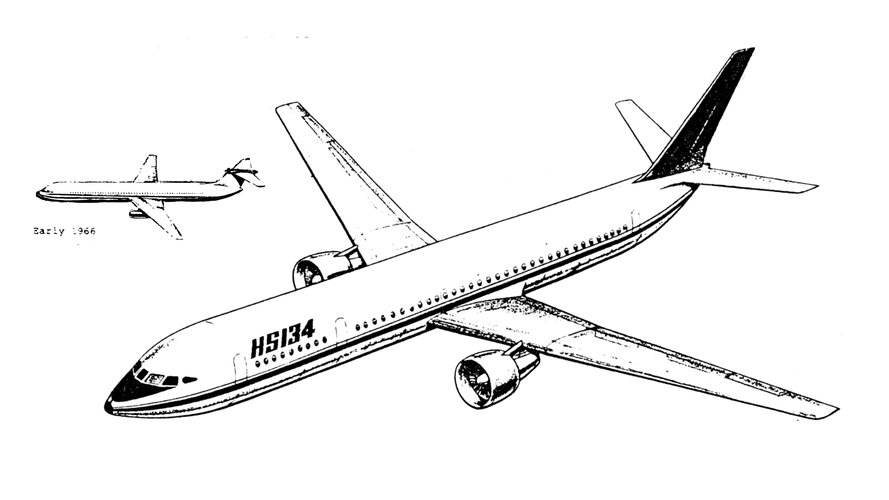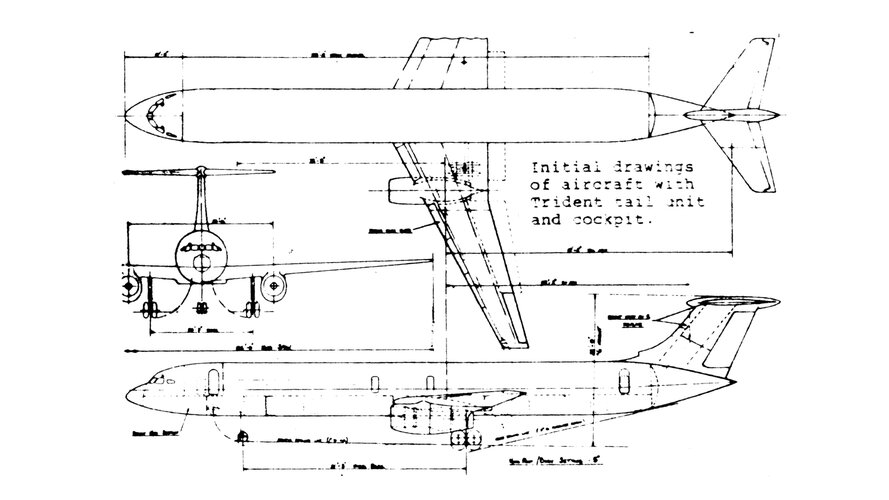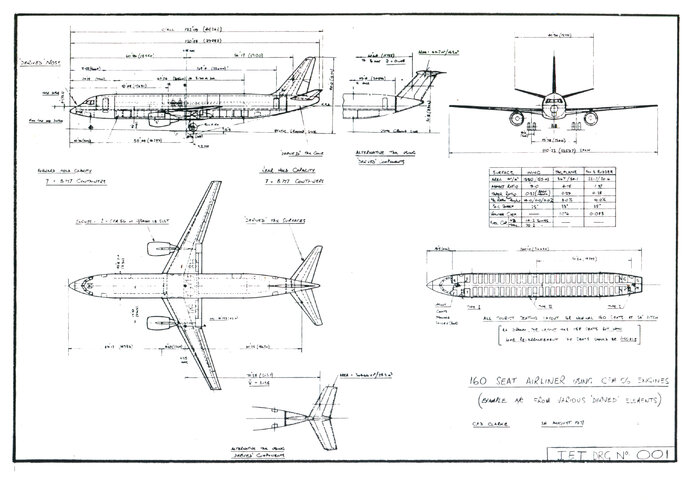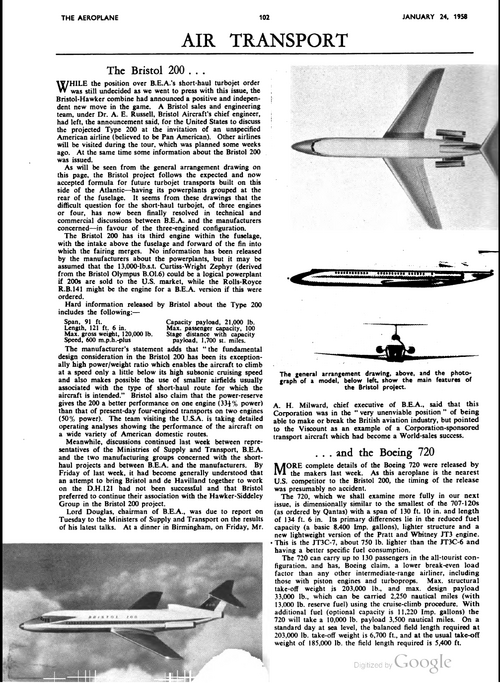zebedee
ACCESS: Secret
From the Hatfield Future Projects Newsletter No.19 November 1987
Investigations into possible stretches of the Trident (HS 132 and 134) for the short-medium range role during 1965 showed that an attractive possibility was the HS 134 with 183 seats at 34" pitch. This aircraft used the Trident cockpit and fuselage diameter and hence many of the components and details appropriate to the Trident fuselage. Two RB 178-14 engines were mounted on a new 25° swept wing. Trident system components were to be used wherever appropriate, but the air conditioning system and other systems affected by passenger capacity and aircraft size were, of necessity, new.
The passenger capacity of the Airbus, on which HSA expect to agree an outline specification with Sud Aviation very soon, is dependent upon the engine finally chosen by the governments concerned, and its seating could range from 240 seats with the JT9 at approximately 41,000 lb. thrust, to 260-270 seats with the RB 207 of 48,000-50,000 lb. thrust.
Market surveys have indicated that such an aircraft is on the large side for BEA and other European operators in the early 1970s, with the exception of Air France and Air Inter who have stated a requirement for a 250 seat arrangement. It is quite possible that a decision mild be taken to proceed with a new Rolls-Royce engine of 28,000-30,000 lb. thrust, since such an engine couldd have a wider application in a new four-engined long range aircraft, as proposed by Douglas, or in a three-engined aircraft, such as those being considered by Lockheed, Douglas and Convair. Further examination has therefore been made of the HS 134 fitted with two RB 207s scaled to 28,000 lb. thrust, the design incorporating the increased knowledge obtained during the last year of Airbus design work.
2x RB207 of 28,000 lb Take off thrust static
Wing Area 1,900 sq.ft.
Sweep 25°
Span 123 ft. 2 ins.
Overall Length 158 ft. 6 ins.
Fuselage external diameter 12 ft. 11 ins.
Image No.1 shows the Mid 1967 Final Configuration, with the earlier T Tail version from 1966 inset.
Image No.2 shows the T Tail Configuration
Image No.3 Shows a similar design from 1977 simply labelled JET 001. Drawn by CFD Clarke this is I think part of the early 'Jet' studies that led to the Airbus A320 and whilst smaller makes use of 'Derived Components'... of note is the 146 style nose...
Zeb
Investigations into possible stretches of the Trident (HS 132 and 134) for the short-medium range role during 1965 showed that an attractive possibility was the HS 134 with 183 seats at 34" pitch. This aircraft used the Trident cockpit and fuselage diameter and hence many of the components and details appropriate to the Trident fuselage. Two RB 178-14 engines were mounted on a new 25° swept wing. Trident system components were to be used wherever appropriate, but the air conditioning system and other systems affected by passenger capacity and aircraft size were, of necessity, new.
The passenger capacity of the Airbus, on which HSA expect to agree an outline specification with Sud Aviation very soon, is dependent upon the engine finally chosen by the governments concerned, and its seating could range from 240 seats with the JT9 at approximately 41,000 lb. thrust, to 260-270 seats with the RB 207 of 48,000-50,000 lb. thrust.
Market surveys have indicated that such an aircraft is on the large side for BEA and other European operators in the early 1970s, with the exception of Air France and Air Inter who have stated a requirement for a 250 seat arrangement. It is quite possible that a decision mild be taken to proceed with a new Rolls-Royce engine of 28,000-30,000 lb. thrust, since such an engine couldd have a wider application in a new four-engined long range aircraft, as proposed by Douglas, or in a three-engined aircraft, such as those being considered by Lockheed, Douglas and Convair. Further examination has therefore been made of the HS 134 fitted with two RB 207s scaled to 28,000 lb. thrust, the design incorporating the increased knowledge obtained during the last year of Airbus design work.
2x RB207 of 28,000 lb Take off thrust static
Wing Area 1,900 sq.ft.
Sweep 25°
Span 123 ft. 2 ins.
Overall Length 158 ft. 6 ins.
Fuselage external diameter 12 ft. 11 ins.
Image No.1 shows the Mid 1967 Final Configuration, with the earlier T Tail version from 1966 inset.
Image No.2 shows the T Tail Configuration
Image No.3 Shows a similar design from 1977 simply labelled JET 001. Drawn by CFD Clarke this is I think part of the early 'Jet' studies that led to the Airbus A320 and whilst smaller makes use of 'Derived Components'... of note is the 146 style nose...
Zeb
Attachments
Last edited:




